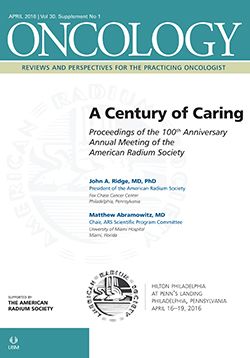(S014) The Impact of Radiation Therapy on Survival in Surgically Resected, High-Risk Patients With Ampullary Adenocarcinoma: A Population-Based Analysis
Radiation therapy is associated with improved survival in surgically resected pT4 or N+ patients with ampullary adenocarcinoma.
Paul P. Koffer, MD, Kathryn Huber, MD, PhD; Tufts Medical Center
OBJECTIVE: The role of radiation therapy (RT) in the setting of surgically resected ampullary adenocarcinoma (AA) is not well defined. We examined the association of RT with survival in resected AA.
METHODS: The Surveillance, Epidemiology, and End Results (SEER) database (8.2.1) was queried for patients with surgically resected AA diagnosed between 2004–2012 and aged = 20 years treated with or without RT. Patients were excluded if they had metastatic disease. Patients who were considered to be at high risk (defined as T4 or N+) were analyzed as a separate subgroup. Baseline characteristics were compared using the chi-squared test. Overall survival (OS) and cause-specific survival (CSS) were analyzed by Kaplan-Meier method and compared using log-rank test. Multivariable analysis with Cox regression was used to assess the association of survival and variables, including T stage, N stage, grade, age, and RT.
RESULTS: A total of 2,034 patients with surgically resected AA were identified. Overall, 25.1% of patients received RT. Patients who received RT were younger (P < .001) and had higher T stage (P < .001), N stage (P < .001), and tumor grade (P < .001). At 5 years, RT use was associated with a worse OS (35.1% vs 43.4%; P =.050) and CSS (41.1% vs 52.5%; P =.005) in the overall cohort on univariate analysis. In the multivariate analysis, RT was not found to be detrimental to OS (hazard ratio [HR], 0.891 [95% CI, 0.763–1.041]) or CSS (HR, 0.811 [95% CI, 0.744–1.044]).
A high-risk cohort of 1,129 patients was identified with T4 or N+ disease, of whom 35.8% received RT. At 5 years, RT was associated with improved OS (30.9% vs 24.2%; P =.001) and CSS (35.5% vs 30.9%; P =.016) on univariate analysis in this high-risk group. In the multivariate analysis, RT maintained its association with improved OS (HR, 0.784 [95% CI, 0.660–0.930]) and CSS (HR, 0.794 [95% CI, 0.661–0.954]) in this group.
CONCLUSION: RT is associated with improved survival in surgically resected pT4 or N+ patients with AA.
Proceedings of the 98th Annual Meeting of the American Radium Society - americanradiumsociety.org
